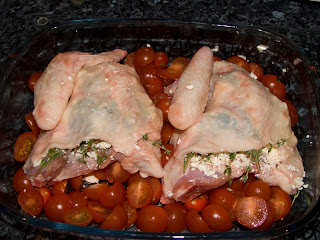You have just come back from a hectic day at work. Cold, tired and hungry, you just want to have a quick shower and enjoy a tasty dinner. You’re way too tired to cook, especially when you want something quickly.
Well, look no further! With this recipe you have no excuse to call for a take away or buy a blunt, tasteless microwave meal. This delicious dish takes 5min to prepare and will be ready by the time you had a shower and dried your hair.
It is way too simple but the sauce created by the tomatoes, wine and olive oil has been described as ‘best ever’, ‘out of this world’, and other similar comments from the people that tried it.
Let’s get on with it though, because I am already starving!!!
For 2 persons you need:
2 pieces of chicken (any part will do, as long as it has the skin on)
100gr Feta cheese
A bunch of fresh thyme
250gr cherry tomatoes (as ripe as possible)
Olive oil for drizzling
Half a glass of white wine
1. Preheat the oven to 190C (gas mark 5)
2. Place the chicken in a shallow ovenproof dish.
3. Loosen the skin from the chicken, crumble the cheese and stuff the chicken with it.
4. Add a few sprigs of thyme.
5. Halve the tomatoes and scatter them around the chicken.
6. Add a few more sprigs of thyme and a drizzle (or more) of olive oil all over the chicken and the tomatoes. Splash the wine over the tomatoes and season with salt and pepper.
7. Bake for 25-30min until the chicken is tender and golden. Half way through you can turn the pieces over to crisp the skin on both sides.
8. Serve immediately. You can accompany the meal with rice, pasta or potatoes. Make sure you have enough bread as the sauce is delicious!
NOTE: In the picture above you can see some potatoes on the side. The recipe for them will follow at another blog.




















































